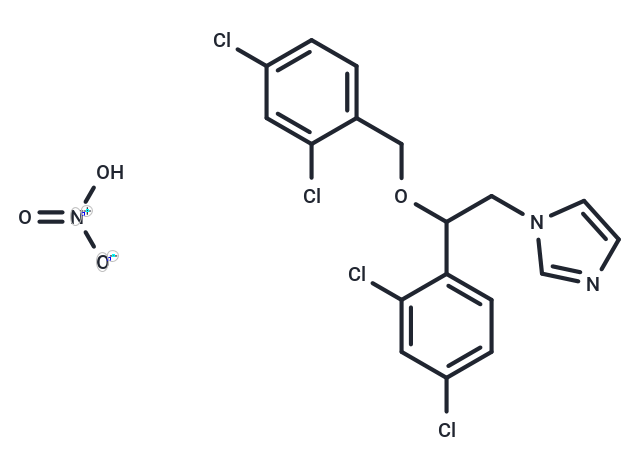Shopping Cart
Remove All Your shopping cart is currently empty
Your shopping cart is currently empty
Miconazole nitrate (R18134 nitrate), an imidazole antifungal agent, selectively affects the integrity of fungal cell membranes, high in ergosterol content and different in composition from mammalian cells membranes.

| Pack Size | Price | USA Warehouse | Global Warehouse | Quantity |
|---|---|---|---|---|
| 1 g | $50 | In Stock | In Stock | |
| 1 mL x 10 mM (in DMSO) | $50 | In Stock | In Stock |
| Description | Miconazole nitrate (R18134 nitrate), an imidazole antifungal agent, selectively affects the integrity of fungal cell membranes, high in ergosterol content and different in composition from mammalian cells membranes. |
| In vitro | Miconazole induces changes in the actin cytoskeleton, indicative of increased filament stability, prior to ROS induction. [1] Miconazole disrupts steroidogenesis in Leydig and adrenal cells by inhibiting 17alpha-hydroxylase/17,20-lyase (P450c17) enzyme activity, thus reducing the conversion of progesterone to androstenedione. Miconazole reversibly inhibits (Bu)(2)cAMP-stimulated progesterone production in a dose- and time-dependent manner in MA-10 cells without affecting total protein synthesis or P450(scc) and 3beta-hydroxysteroid dehydrogenase (3beta-HSD) enzyme expression or activity. [2] Miconazole is known to interfere with the synthesis of fungal and bacterial lipid membranes as it restrains the synthesis of Ergosterol which results in accumulation of toxic methylated sterol intermediates in membranes and subsequently in fungal cell growth arrests. [3] Miconazole induces actin cytoskeleton stabilization in Saccharomyces cerevisiae prior to induction of reactive oxygen species, pointing to an ancillary mode of action. [4] Miconazole treatment releases Ca(2+) from the thapsigargin (TG)-sensitive ER pool of WEHI7.2 cells. Miconazole induces apoptosis, based on morphological and biochemical criteria, and on inhibition by the Bcl-2 oncogene. Miconazole–induced intracellular Ca(2+) changes is inhibited by overexpression of Bcl-2. Miconazole induces apoptosis in the glucocorticoid sensitive and resistant human T-cell leukemia lines, CEM-C7 and CEM-C1 respectively, in normal thymocytes and in normal lymphocytes, in addition to inducing cell death in WEHI7.2 cells. [5] |
| Synonyms | R18134 nitrate, NSC 169434 Nitrate |
| Molecular Weight | 479.15 |
| Formula | C18H15Cl4N3O4 |
| Cas No. | 22832-87-7 |
| Smiles | O[N+]([O-])=O.Clc1ccc(COC(Cn2ccnc2)c2ccc(Cl)cc2Cl)c(Cl)c1 |
| Relative Density. | 1.451g/cm3 |
| Storage | Powder: -20°C for 3 years | In solvent: -80°C for 1 year | Shipping with blue ice/Shipping at ambient temperature. | ||||||||||||||||||||||||||||||||||||||||
| Solubility Information | DMSO: 60 mg/mL (125.22 mM), Sonication is recommended. Ethanol: 4.8 mg/mL (10.02 mM), Sonication is recommended. | ||||||||||||||||||||||||||||||||||||||||
| In Vivo Formulation | 10% DMSO+40% PEG300+5% Tween 80+45% Saline: 2 mg/mL (4.17 mM), Sonication is recommended. Please add the solvents sequentially, clarifying the solution as much as possible before adding the next one. Dissolve by heating and/or sonication if necessary. Working solution is recommended to be prepared and used immediately. The formulation provided above is for reference purposes only. In vivo formulations may vary and should be modified based on specific experimental conditions. | ||||||||||||||||||||||||||||||||||||||||
Solution Preparation Table | |||||||||||||||||||||||||||||||||||||||||
Ethanol/DMSO
DMSO
| |||||||||||||||||||||||||||||||||||||||||
| Size | Quantity | Unit Price | Amount | Operation |
|---|

Copyright © 2015-2025 TargetMol Chemicals Inc. All Rights Reserved.